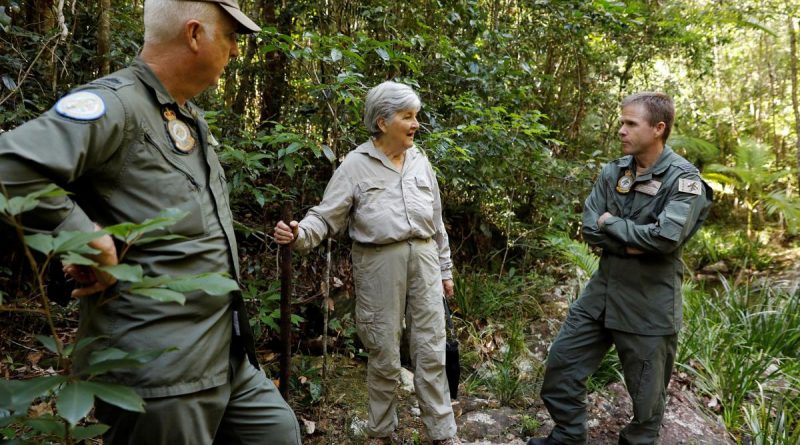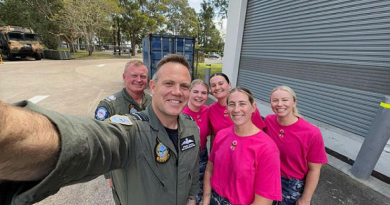Survival school honours POW

For courage shown by the only RAAF prisoner of war (POW) who was on the infamous Sandakan death march 76 years ago, the late Warrant Officer John Kinder has been honoured by the school that teaches survivability to ADF aircrew.
CAPTION: Historian Lynette Silver visits the jungle training area of Air Force’s Combat Survival Training School with instructor Warrant Officer Shane Grist, left, and Commanding Officer Squadron Leader Simon Longley. Story and photo by Corporal Veronica O’Hara.
The Paluma jungle area where the Combat Survival Training School (CSTS) conducts training, known as a forward operating base or FOB, is now referred to as FOB Kinder.
After visiting the area, researcher and author Lynette Silver said the FOB Kinder jungle was comparable to the Sandakan-Ranau route the POWs were forced to march during World War II.
“I was quite struck by how similar they were – you’d think you were on that mountainside in the middle of Borneo, on the parts of the track where you can still walk,” Mrs Silver said.
Nephew of Warrant Officer Kinder, John Pope said it was nice to know his name lived on through the FOB, but it also paid tribute to the nearly 2500 POWs forgotten in Borneo.
“I’ve been there and walked in his footsteps. I used to think he could have escaped, but where do you go in the jungle?” Mr Pope said.
“It was a demanding and gruelling few years for him.”
Mrs Silver said she believed Warrant Officer Kinder was one of the most heroic figures to come out of the Sandakan story.
“You’d have to be brave to stand up to someone who’s wielding a rifle, putting yourself physically between one of your men and the aggressor then take their punishment, knowing that every time you stood up to them, you’re going to get belted or worse,” she said.
CSTS aims to instil the tenacity and will to survive an isolating incident in ADF aviators.
Experiences of POWs from the Korean War sparked the establishment of combat survival training by Air Force.
Commanding Officer CSTS Squadron Leader Simon Longley said the school’s training methods were born from those who endured hardships difficult to imagine.
“Despite facing extreme adversity, Warrant Officer Kinder was able to rally the troops and care for them up until his death,” Squadron Leader Longley said.
The death toll would have been much higher on the marches, according to Mrs Silver, if POWs didn’t have the will to survive.
Even so, of the camp’s nearly 2500 prisoners, the six Australians who escaped were the sole survivors.
“The indomitability of the human spirit is very inspirational, especially if you saw what it’s like over there,” Mrs Silver said.
“But the biggest thing was they also had each other.”
While they didn’t know where they were going or what was at the end, Mrs Silver said the starving prisoners focused on putting one foot after the other, to hopefully last the day.
“They thought if they got to the end of this nightmare, perhaps the war would finish and they’d go home,” she said.
“If they had any idea what was in store, they wouldn’t have walked another step.”
A lot of the skills POWs had were learnt from scouts or working on the land.
They had to mend and make do, especially during the Depression, but a lot of these skills don’t widely exist today.
“I think he’d [Warrant Officer Kinder] be quite surprised we have to teach people how to do this stuff these days,” Mrs Silver said.
One of eight camp masters and a lone aviator amongst AIF soldiers, Warrant Officer Kinder was only one of two that the rank and file would obey, which Mrs Silver said gave an idea of the way he approached leadership.
“When you’re given the job of distributing rations in a POW camp where food is getting scarcer, everybody is watching everybody else like a hawk to make sure no one gets a grain of rice more than they’ve got,” she said.
“That means he was fair-minded and wasn’t giving food to mates on the side.”
After Warrant Officer Kinder’s death, his friend and unofficial deputy, Lance Bombardier William Moxham, an artilleryman who only obeyed an order if he felt like it, buried the aviator with a cross.
Warrant Officer Kinder was the only man who died on the march who had a marked grave, according to Mrs Silver.
In the Labuan War Cemetery among rows of unmarked graves, Warrant Officer Kinder’s bronze plaque reads: “His Duty Nobly Done – Ever Remembered”.
“I think you’d be hard put to find a better epitaph. He is very deserving of it – for showing leadership, bravery, compassion and selflessness,” Mrs Silver said.
Mr Pope said he felt his uncle missed out on the chance to survive because his promotion to an officer wasn’t received on time and he would have been moved to Kuching instead of doing the march from the Sandakan camp.
“Nobody knew what had happened to him for a long time, even after the war ended,” Mr Pope said.
“It wasn’t just the men lost, it destroyed so many families.”
Warrant Officer Kinder’s mother and grandmother searched everywhere, even meeting the returning troop ships, desperately hoping he’d be on one.
Mr Pope’s mother died three years before Mrs Silver’s book on the Sandakan tragedy was released in 1998, never knowing exactly what had happened to her brother.
Warrant Officer Kinder was a boxer before joining Air Force and his trophies made him a hero in Mr Pope’s young eyes.
“The huge trophies and photo albums from Malaya at my grandmother’s house made me curious as to what happened to him,” Mr Pope said.
“It’s been a good journey to find out.”
Continuing their homage to Australian POWs, CSTS also has named the conference room The Sandakan Room, displaying a photograph of three of the six escapees and four natives who assisted them.
.
.

.
.





